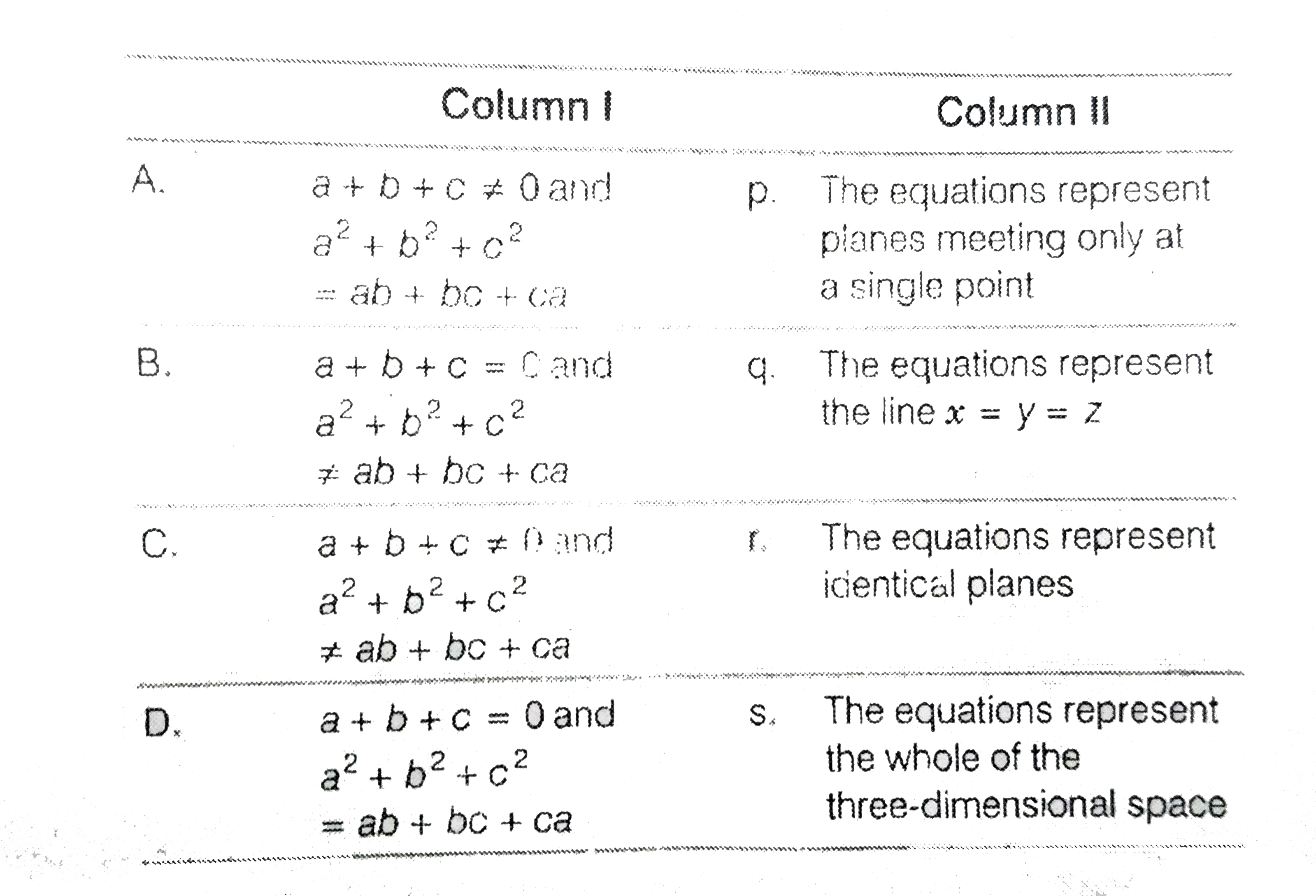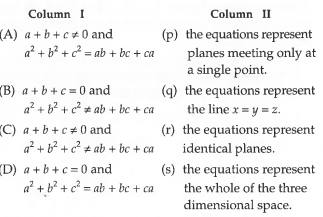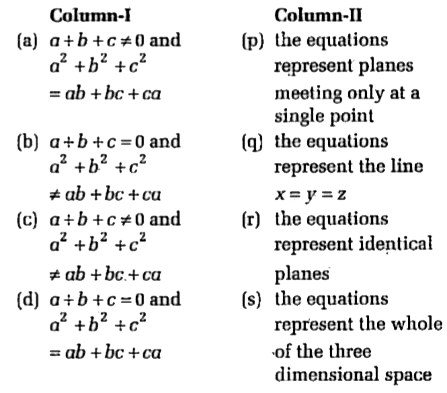Consider the linear equations ax+by+cz=0,bx+cy+az=0andcx+ay+bz=0.
Match the conditions/expressions in Column I with statements in Column II.

Text Solution
The correct Answer is:a→r;b→q;c→p;d→s
Here we have the determinant of the coefficient matrix of given equation as
Δ=∣∣
∣∣abcbcacab∣∣
∣∣
=−(a+b+c)(a2+b2+c2−ab−bc−ca)
=−12(a+b+c)[(a−b)2+(b−c)2+(c−a)2]
a. a+b+c≠0
and a2+b2+c2−ab−bc−ca=0
or (a−b)2+(b−c)2+(c−a)2=0
or a=b=c
Therefore, this question represents identical planes.
b. a+b+c=0
and a2+b2+c2−ab−bc−ca≠0
This means Δ=0anda,bandc are not all equal. Therefore, all equations are not identical but have infinite solutions. Hence,
ax+by=(a+b)z (using a+b+c=0)
and bx+cy=(b+c)z
⇒ (b2−ac)y=(b2−ac)z⇒y=z
rArr ax+by+cy=0⇒ax=ay
⇒ x=y=z
Therefore, the equations represent the line x=y=z.
c. a+b+c≠0anda2+b2+c2−ab−bc−ca≠0
⇒ Δ≠0 and the equations have only trivial solution, i.e., x=y=z=0.
Therefore, the equations represent the planes meeting at a single point, namely origin.
d. a+b+c=0anda2+b2+c2−ab−bc−ca=0
⇒ a=b=candΔ=0⇒a=b=c=0
⇒ All equations are satisfied by all x,yandz.
⇒ The equations represent the whole of the three-dimensional space.
|
Topper's Solved these Questions
- THREE-DIMENSIONAL GEOMETRY Book:CENGAGEChapter:THREE-DIMENSIONAL GEOMETRY Exercise:Exercise (Numerical)
Explore 10 Videos
- THREE DIMENSIONAL GEOMETRYBook:CENGAGEChapter:THREE DIMENSIONAL GEOMETRYExercise:Question Bank
Explore 20 Videos
- TRIGNOMETRIC RATIOS IDENTITIES AND TRIGNOMETRIC EQUATIONSBook:CENGAGEChapter:TRIGNOMETRIC RATIOS IDENTITIES AND TRIGNOMETRIC EQUATIONSExercise:Question Bank
Explore 34 Videos
Similar Questions
Knowledge Check
Three lines px+qy+r=0, qx+ry+p=0 and rx+py+q=0 are concurrent , if
AΣa3=3abcBσa=0CΣa2=ΣabDNoneThe three lines ax+by+c=0,
bx+cy+a=0,cx+ay+b=0
are concurrent only whenAa+b+c=0Ba2+b2+c2=ab+bc+caCa3+b3+c3=3abDNone of these
Match the conditions /expression n Column I with statement in Column II (z≠0 is a complex number )

View SolutionConsider the following linear equations
ax+by+cz=0,bx+cy+az=0,cx+ay+bz=0

View SolutionConsider the following linear equations ax+by+cz=0,bx+cy+az=0,cx+ay+bz=0.Matchthestatement∈ColumnIwiththe∝erties∈ColumnIIand∈dicateyouranswerbydarken∈gtheap∝riatebu≤s∈the4 xx 4 matrix given in the ORS.

View SolutionConsider the following linear equations
ax+by+cz=0,bx+cy+az=0,cx+ay+bz=0

View SolutionIf the lines ax+by+c=0,bx+cy+a=0 and cx+ay+b=0 be concurrent, then:
View SolutionIf the lines ax+by+c=0,bx+cy+a=0andcx+ay+b=0a≠b≠c are concurrent then the point of concurrency is
View Solution

